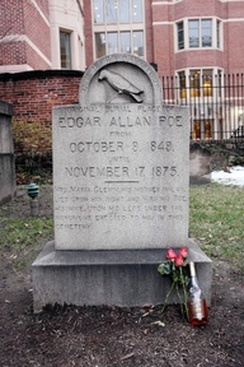|
Alas, another year passes without the appearance of the “Poe Toaster” at the grave of American writer Edgar Allen Poe. For decades, some secretive individual clothed in black had been paying midnight visits to the author’s grave in Baltimore, Maryland on January 19th, the anniversary of the author’s birth in 1809. The visitor would salute the author with a glass of cognac, then leave three red roses and the unfinished bottle of Martell on the gravestone. This “tradition” started sometime in the 1930s (although it was not reported in print until 1950) and continued until 2009. The visits have ceased, just as mysteriously as they started. Of course, there are "faux" Poe toasters (fauxsters?) who are carrying on in the elusive footsteps of the original, but they lack a certain style and grace. The original was determined to remain anonymous. The imitators, inevitably in the post-privacy age, want the publicity. Read more about this intrigue surrounding the American master of the macabre at The Washington Post.
0 Comments
Can't be pushed...must be found...can be guided...by the right hand, a librarian's hand, of course!  The unveiling: LBJ is particularly entranced January 13th marks the 50th anniversary of Mona Lisa's famous debut in the United States. Her unveiling at the National Gallery of Art in Washington, D.C. was reminiscent of a coronation, presided over by triumphant First Lady Jacqueline Kennedy, who had been instrumental in negotiations with the French government to send the priceless painting on its first overseas trip. Using her considerable powers of persuasion (and her knack for speaking French), she convinced France's Minister of Culture, Andre Malraux, that an artistic exchange of this magnitude would strengthen the cultural ties between the nations. French President Charles de Gaulle, who was looking to cement his stature on the international political scene during the cold-war years, saw it from a different perspective. He wanted to develop a nuclear arsenal and needed the tacit support of the American government to do it. If the mysterious, come-hither smile of a 450 year old woman could seal the deal, well, son sac dans le coffre et l'envoyer sur l'océan. To read more about the adventures of the first lady of art, you don't have to cross the seas. Just venture to your local library for these entertaining reads:  Mona Lisa in Camelot Davis, Margaret L. (Da Capo Press, 2008) The author details the story of the 1963 American exhibition of the Mona Lisa in New York City and Washington, D.C. It was America's first blockbuster art show and the populace was gripped by "Mona mania." It's all here: the negotiations, preparations, flummoxes (the painting wound up being poorly lit in D.C.) and successes of the exhibit, along with plenty of inside dope on Jackie's phenomenal wardrobe.  Vanished Smile: the mysterious theft of the Mona Lisa Scotti, R. A. (Knopf, 2009) This is a spritely account of the brazen 1911 theft of the Mona Lisa from the Louvre and the two-year quest to bring her home. On the morning of August 22, La Joconde was found missing from the Salon Carré. Even with help of renowned French criminologist Alphonse Bertillon, the trail was cold from the start. Rumors abounded about greedy, wealthy American collectors and the Louvre’s lax security. No one in Paris was above suspicion, not even the young Pablo Picasso. While the portrait was finally recovered in Florence in 1913, its theft apparently the result of a young Italian’s misguided patriotism, the author reminds readers that the mystery is far from over. The true motive for the theft—and the possible connection to a larger ring of art thieves—remains unknown.  Scandals, vandals and DaVincis: a gallery of remarkable art tales Rachlin, Harvey (Penguin, 2007) For a mix of art gossip and intrigue, here's light-hearted but occasionally riveting account of the backstories of 26 famous paintings, beginning with the Mona Lisa. The author takes a close-up look at the secret histories of these masterpieces, including Gilbert Stuart's Athenaeum Head of George Washington, the world's most reproduced image (on the $1 bill). He describes how they came to be created and how they survived forgery, revolution, burglary, vandalism, ransoms, scandal, religious turmoil, and shipwrecks to become to some of the world's most priceless works of art. |
AuthorTo find out more about me, click on the Not Your Average Jo tab. Archives
February 2024
Categories
All
|


 RSS Feed
RSS Feed